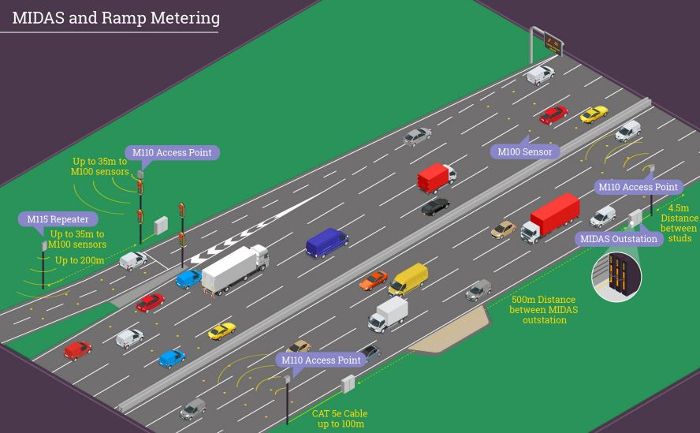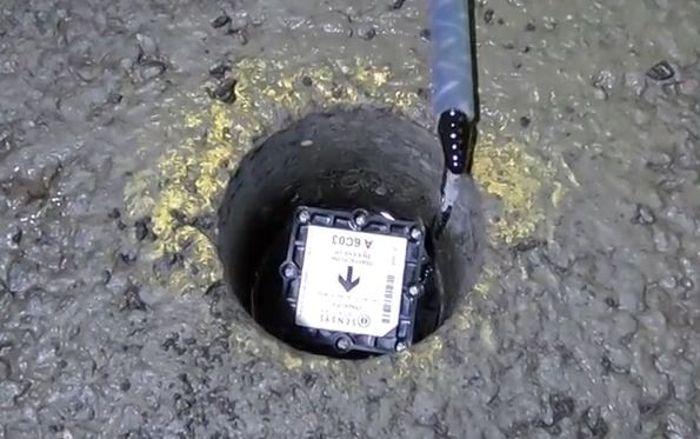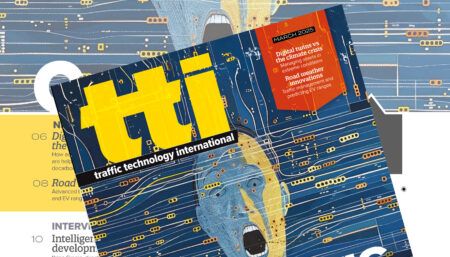An investigation into the performance of Clearview Intelligence’s magnetometers as an alternative to inductive loops on MIDAS (Motorway Incident Detection and Automatic Signaling) installations has concluded they deliver like-for-like results with additional benefits.
A project group comprising representatives of Clearview Intelligence, Highways England (HE), A-one+, Connect Roads, and Mway Comms undertook a 12-month trial on the A1/M1 connect DBFO linking to a MIDAS site. The study compared the performance of magnetometers and loops when monitoring speed, traffic flow, and classification of vehicles and concluded the magnetometer trial to be a ‘success’. The Jacobs consultancy, which compiled the findings report on behalf of A-one+ concluded: ‘There are many benefits of installing magnetometers at MIDAS sites over the traditional inductive loop technology. The conclusion of this report is that under similar circumstances and with the same installation methodology, the magnetometers are a suitable alternative to inductive loop detection.’

Connect Roads had previously been managing a lane surfacing strategy that created additional re-cutting of loops and subsequent increased degradation of the road surface. HE was also struggling to build a viable business case for a full radar-detection deployment, so agreed to a commission of Clearview’s M100 magnetometers under a trial basis. Unlike inductive loops that are installed across the width of the carriageway, the M100 is cored in the center of the lane, thus avoiding the natural wearing course. The sensors detect changes in the earth’s magnetic field caused by passing vehicles, to provide detection data equivalent to that generated by inductive loops.
 With a battery life of between eight and 10 years, the trial recognized the installation and replacement of magnetometers was ‘far less onerous’ than loops when considering the time, cost and traffic management, as well as the M100 being non-invasive to the road surface. Clearview’s magnetometers are up to four times faster to install than traditional loops and because they are battery operated, they can be installed independently of each other which reduces the need for full carriageway closures. They can also be installed to a depth of up to 6.5in (16.5cm), which can allow for carriageways to be resurfaced without the need to remove and reinstall the magnetometers. Following completion of the trial, the data was submitted to and accepted by the National Information Service which confirmed the data was ‘suitable for vehicle clarification’.
With a battery life of between eight and 10 years, the trial recognized the installation and replacement of magnetometers was ‘far less onerous’ than loops when considering the time, cost and traffic management, as well as the M100 being non-invasive to the road surface. Clearview’s magnetometers are up to four times faster to install than traditional loops and because they are battery operated, they can be installed independently of each other which reduces the need for full carriageway closures. They can also be installed to a depth of up to 6.5in (16.5cm), which can allow for carriageways to be resurfaced without the need to remove and reinstall the magnetometers. Following completion of the trial, the data was submitted to and accepted by the National Information Service which confirmed the data was ‘suitable for vehicle clarification’.
“Having worked with some of the industry’s leading partners to commission this trial, we hope the results will give operators the confidence to look beyond inductive loops for vehicle detection and consider the M100. As well as providing like-for-like results, the benefits of installing and maintaining the magnetometers compared with inductive loops were also recognized,” noted Andy Salotti, Clearview’s director of solutions. “This trial confirms what we have known for a long time; our wireless vehicle detection is a reliable and accurate alternative to inductive loops on MIDAS schemes. So much so, we now offer all our magnetometers with a five-year warranty to guarantee their performance and offer free CPD-accredited installation training to support the implementation of the system.”





